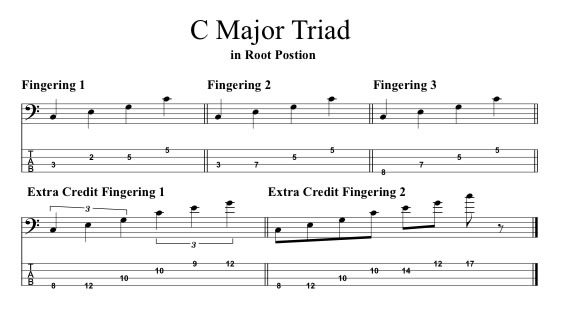Bass Edu
Chord Tone/Arpeggio Lesson 1

Chord Tone/Arpeggio Lesson 1…
One of the most common ways that we initially learn to play the bass is to “head on down” to our local music store in search of an instructor. This instructor will be someone that we will typically put our complete blind musical faith into, a man (or woman) who will ultimately shape the way in which we view the musical world, whether we are aware of it or not.
If you are anything like me or the large majority of students that I have inherited from previous instructors, the standard starting point is the age old “scales and modes” method. This seems like a great starting point, I mean, we all have to get that musical knowledge somehow, right? So you go for a few lessons and learn the major scale, in the meanwhile your guitar playing counterpart is already starting to strum open chords, stringing them together in ways that are now starting to resemble songs. So you guys decide to get together to start jamming and you notice several things right off of the bat. Your buddy tells you the chords are G-C-D and starts to strum, you immediately start to follow him, playing G on the G chord,C on the C chord,and D on the D chord. After figuring out the basic idea and groove, you start hearing new ideas in your head and you feel the need to expand, the only problem is that every time you try and play the G major scale (that you have been working on for weeks now) half of the notes sound strange, some even sound flat out wrong. Why is this? The song is in the key of G major after all and and you’re playing the G major scale, this should sound great, right? Well, there are a plethora of reasons for why this is probably not working but in this lesson we are going to start by focusing on one, the Arpeggio, more specifically the triad.
When most instrumentalists start their journey, the focus is usually on basic technique as well as learning songs. If you weren’t a bass player, the large majority of the time that you spent behind your instrument you’d probably be strumming chords on guitar or pounding out chords on the piano. This approach sounds much more like music as opposed to banging on root notes or running up and down scales. In fact, the bass in its traditional role is linear, which is already a bit “backwards” when compared to its chordal (harmonic) counterparts. This is why in my opinion that arpeggios/chord tones make the most sense as a starting point when it comes to the bass.
By definition, an arpeggio is the notes of a chord played linearly, or one note at a time. If when we learn most other instruments we pretty much start with chords, it makes sense that we should learn the “chordal” counterpart on the bass as well. If done correctly, this should get us on the same page as guitar playing and piano playing peers relatively quickly.
At the most fundamental level of arpeggio study is the TRIAD, a 3 note chord based on the 1st, 3rd and the 5th degree of a scale. Without tampering with it at all (adding sharps and flats) we get a Major Triad, if we flat the 3rd we get a Minor Triad, if we flat the 3rd and the 5th we get a Diminished Triad, and if we raise the 5th we get an Augmented Triad. This gives us a whopping grand total of only 4 triads : major, minor, diminished and augmented, no more no less. This very small finite number of 4 is something that I absolutely love, with music being an art there are endless possibilities, so when anything comes along that is easily quantifiable I make it a point to absorb it as best I can. At the risk of being overly repetitive say them to yourself again, Major Triad, Minor Triad, Diminished Triad and Augmented Triad. Remember that the goal is to completely absorb this information, this may come quickly to some people an not so much to others, no matter what the case may be please take the time needed to internalize all 4 triads. After all, no matter how good you get or what genre of music that you play, you will be using the triads for the rest of your musical life.
We will start with a major triad, a major triad pairs up with its corresponding major chord. In other words, if a guitar/piano player tells you that they are playing a C Major Chord then a C Major Triad would be the perfect choice, if they tell you that they are playing a B flat Major Chord then a B flat Major Triad would work great. Remember, my goal is to give you the information, the artistry of how the information is played is up to you. And yes, just in case you were wondering there are more advanced applications but you have to start somewhere, right? Just keep practicing and we’ll get there soon enough.

C Major Triad
-Comprised of the notes C,E,G
-Comprised of the intervals 1,3,5
-Corresponds with the C Major Chord
-Written as “C” on chord chart
Bass Edu
BASS LINES: Triads & Inversions Part I

Triads & Inversions Part I…
Hello bass players and bass fans! In this issue, we are going to study the triads and their inversions.
It is very important for all bassists to understand and master the triads, but it is even more important to understand their different inversions.
In Part I, we are going to learn what the triad is in fundamental position.
The Formula consists of root, third and fifth.
Degrees of the Triad
Major Triad: 1 – 3 – 5
Minor Triad: 1 – b3 – 5
Diminished Triad: 1 – b3 – b5
Augmented Triad: 1 – 3 – #5
Fig.1 – The C, Cm, Cdim & Caug triads
(Fundamental Position)
Bass Edu
Premiere! Bass Playthrough With Foetal Juice’s Bassist Lewis Bridges – From the Album, Grotesque

Premiere! Bass Playthrough With Foetal Juice’s Bassist Lewis Bridges – From the Album, Grotesque
Bassist Lewis Bridges Shares…
“Gruesome’s sparse intro marks a stark contrast from the intensity of the rest of the album. The original intention was to keep the bass simple but colourful, however as I worked on it, the lines grew more expressive and the more striking flourishes began to emerge. The intensity builds into a harmonic minor passage that takes us into the drop — a signature death grind cacophony. This is where Foetal Juice thrives. You’re getting a full-on right-hand barrage to in the face to take you into a groove-laden mulch-fest.
I owe my throbbing bass tone to the Darkglass Alpha Omega pedal borrowed from our sound engineer, Chris Fielding (ex-Conan), mixed with the clarity of the tried and true Ampeg SVT CL.
As mentioned earlier, colourful basslines are important, especially in a one-guitar band. Chucking some funny intervals and odd flourishes here and there brings life into the brutality. There’s no point sounding brutal if it’s not gonna be fucking evil too!
Recording this playthrough was hard work. This was not the fault of James Goodwin (Necronautical), who was kindly filming and is ace to work with, but because in true Foetal fashion, we had stinking hangovers — and that jam room was hot!”
Follow Online
FB @FoetalJuice
TW @FoetalJuice
IG @foetaljuice
Youtube: @Foetaljuice
Spotify
Foetaljuice.bandcamp.com
Bass Edu
Bass Lines: The Circle

Bass Lines: The Circle…
Hello bass players and fans of bass! This month we’re going to study “The Circle.”
The Circle of Fourths can also be called “The Circle of Fifths or just The Circle.
Practicing the scales, chords, and ideas in general via the circle has been a common practice routine for jazz musicians and highly recommended.
It is a disciplined way of working through all twelve keys.
Plus, many bass root movements to jazz and pop songs move through sections of the circle.
Fig. 1 – “The Circle”

See you next month for more full bass attack!
#bassmusicianmag, #basslines, #bmmbasslines, #groovemaniac, #thecircle, #thecircleoffourths, #thecircleoffifths,#scales & #chords.
Bass Edu
Approach Notes – Part 5

Continuing our lesson of Approach Notes, Part 5…
In continuing with the concept of approach notes being applied to chord tones, this lesson approaches the root, third, fifth, and seventh degree of each arpeggio inversion by incorporating a double chromatic approach from above, and a single chromatic approach from below.
The first examples approach the root of a G major 7th arpeggio as a double chromatic from above and a single chromatic approach from below -before continuing to the third, fifth, seventh, double chromatic from above/ single from below to the root, continue to the third, fifth, and come back down.
The next example approaches the first inversion of G major 7th arpeggio.
A double chromatic from above/ single from below approaches the third, continue to the fifth, seventh, root, double chromatic from above/ single below to the third, continue up to the fifth and seventh, and back down.
The third example approaches a second inversion of a G major arpeggio.
A double chromatic from above/ single from below approaches the fifth, continue to the 7th, root, 3rd, double chromatic from above/ single from below to the 5th, continue to the 7th, root, and back down.
This final example approaches a third inversion of a G major 7th arpeggio.
A double chromatic from above and below approaches the 7th, continue to the root, 3rd, 5th, double chromatic from above and below to the 7th, continue to the root, 3rd, and back down.

Be sure to pace yourself with these lessons to avoid burning out.
Being overly ambitious with your practice schedule can lead to unrealistic expectations. Try learning one approach note concept and one chord type a week. Change your practice routine as necessary and tailor it to your needs as a musician. Good luck!
Bass Edu
BASS LINES – The Blue Notes (Minor Blues Scale)

Hello bass players and bass fans! Happy New Year 2024!
In this issue, we are going to study the blue notes.
In blues, jazz, and rock, a blue note is a note that (for expressive purposes) is sung or played at a slightly different pitch from standard. Typically the alteration is between a quartertone and a semitone, but this varies depending on the musical context.
The blue notes are usually said to be the lowered third(b3), lowered fifth(b5) and lowered seventh(b7) scale degrees. The lowered fifth(b5) is also known as the raised fourth(#4). Though the blues scale has “an inherent minor tonality, it is commonly ‘forced’ over major-key chord changes, resulting in a distinctively dissonant conflict of tonalities”.
Blue notes are used in many blues songs, in jazz, rock and in conventional popular songs with a “blue” feeling.
Formula:
The A Minor Blues Scale
1 – b3 – 4 – (#4/b5) – 5 – b7
A – C – D – (D#/Eb) – E – Bb
The grades(blue notes):
b3, (#4/b5), b7
C, (D#/Eb), Bb
See you next month for more full bass attack!
#bassmusicianmag, #basslines, #bmmbasslines, #groovemaniac, #thebluenotes, #minorbluesscale & #bluesscale

















